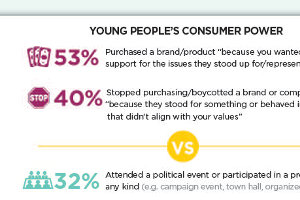
Business is business, but most people appreciate a brand that also does good in the world. Sometimes that good comes from a product (think LifeStraw), but even brands that create less altruistic products can still have a positive impact.
And that impact can be important to consumers, especially young ones. More than half of young people have purchased a brand or product to show support for an issue the brand represented, and 40% have stopped purchasing because a brand didn’t align with their values.
Those stats are based on a report by DoSomething Strategic, the data-driving consultancy arm of DoSomething.org.
The group also created a brand-ethos hierarchy as a road map to help brands figure out how to drive the social change young people are looking for:
- Level 1 (the base): All are welcome
- Level 2: The brand cares
- Level 3: Caring as an integral part of the brand story
- Level 4: Engaging for direct impact
- Level 5 (top): Living the purpose
Does it make sense for your brand to be part of social change? Check out the infographic to learn more. Tap or click to see a larger version.

Laura Forer is a freelance writer, email and content strategist, and crossword puzzle enthusiast. She’s an assistant editor at MarketingProfs, where she manages infographic submissions, among other things.
